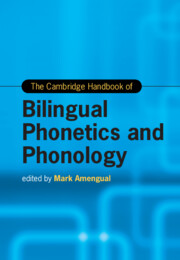Book contents
- The Cambridge Handbook of Bilingual Phonetics and Phonology
- Cambridge Handbooks in Language and Linguistics
- The Cambridge Handbook of Bilingual Phonetics and Phonology
- Copyright page
- Dedication
- Contents
- Figures
- Tables
- Contributors
- Acknowledgments
- Introduction Bilingual Phonetics and Phonology
- Part I Approaches to Bilingual Phonetics and Phonology
- Part II Theoretical Models of Bilingual Phonetics and Phonology
- Part III The Phonetics and Phonology of the Bilingual Child
- 12 The Speech Perception of Bilingual Infants
- 13 The Speech Production of Bilingual Children
- 14 Phonological Disorders in Child Bilingualism
- 15 Acquisition of Segmental Phonology in Child Bilingualism
- 16 Acquisition of Suprasegmental Phonology in Child Bilingualism
- Part IV The Phonetics and Phonology of the Bilingual Adult
- Part V The Diversity of Bilingual Speakers
- Part VI Variables and Outcomes of Bilingual Speech
- Index
- References
12 - The Speech Perception of Bilingual Infants
from Part III - The Phonetics and Phonology of the Bilingual Child
Published online by Cambridge University Press: 14 November 2024
- The Cambridge Handbook of Bilingual Phonetics and Phonology
- Cambridge Handbooks in Language and Linguistics
- The Cambridge Handbook of Bilingual Phonetics and Phonology
- Copyright page
- Dedication
- Contents
- Figures
- Tables
- Contributors
- Acknowledgments
- Introduction Bilingual Phonetics and Phonology
- Part I Approaches to Bilingual Phonetics and Phonology
- Part II Theoretical Models of Bilingual Phonetics and Phonology
- Part III The Phonetics and Phonology of the Bilingual Child
- 12 The Speech Perception of Bilingual Infants
- 13 The Speech Production of Bilingual Children
- 14 Phonological Disorders in Child Bilingualism
- 15 Acquisition of Segmental Phonology in Child Bilingualism
- 16 Acquisition of Suprasegmental Phonology in Child Bilingualism
- Part IV The Phonetics and Phonology of the Bilingual Adult
- Part V The Diversity of Bilingual Speakers
- Part VI Variables and Outcomes of Bilingual Speech
- Index
- References
Summary
Over the last ten years, research on groups of infants and toddlers acquiring more than one language from birth has grown rapidly, though it still trails the research on infants learning just one language. This chapter discusses behavioural and neurophysiological findings about how bilinguals perceive spoken language in the first three years of life. This research demonstrates that bilingual and monolingual infants use similar core mechanisms to learn from differing linguistic input. Crucially, comparing their acquisition trajectories allows us to make inferences about the early linguistic representations of bilingual infants.
Keywords
- Type
- Chapter
- Information
- The Cambridge Handbook of Bilingual Phonetics and Phonology , pp. 263 - 284Publisher: Cambridge University PressPrint publication year: 2024

